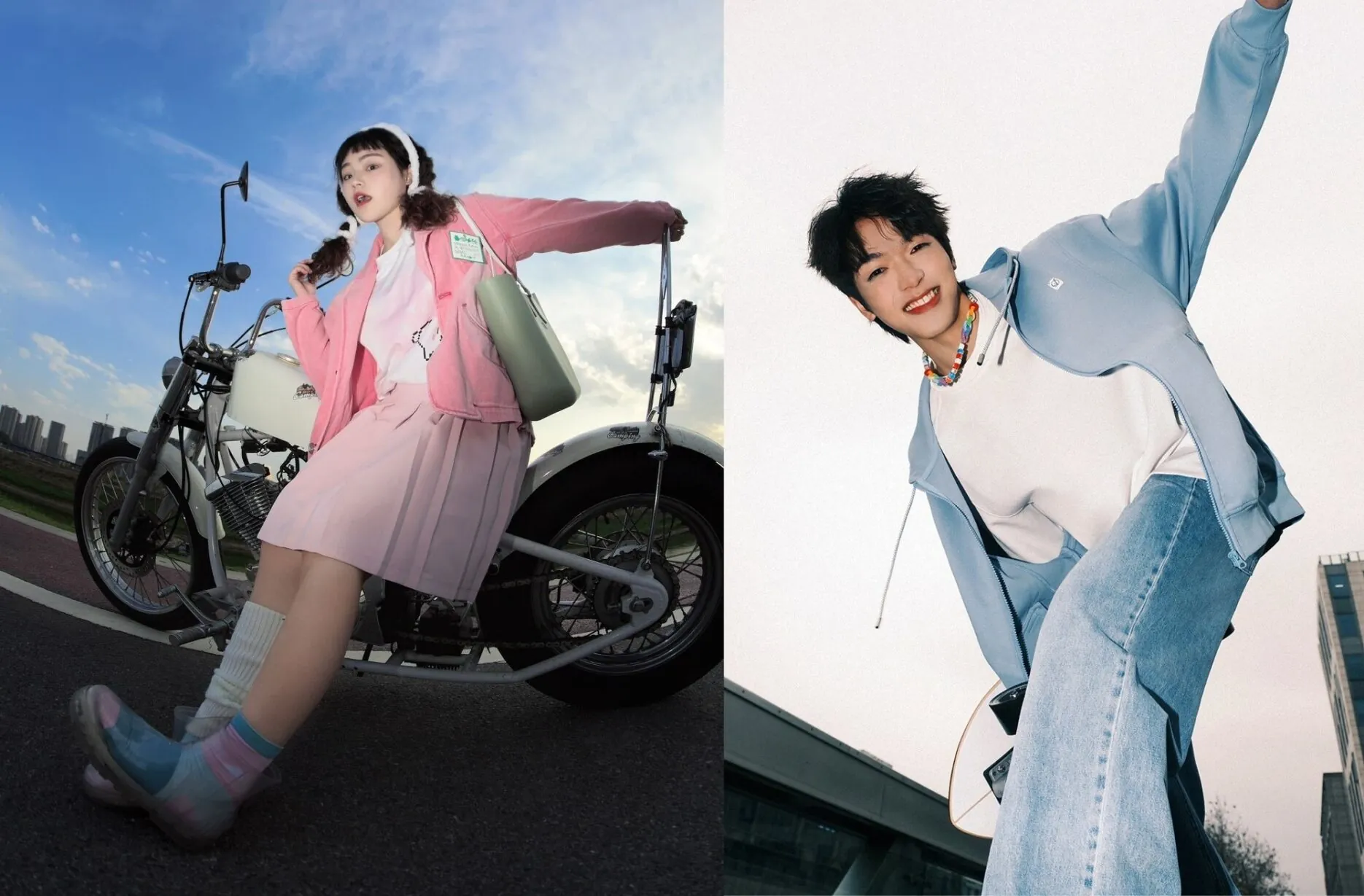About a hundred years ago, French couturier Coco Chanel pioneered women’s trousers and revolutionised the course of women’s fashion. Her challenging move and defiance of gender norms has inspired so many and passed through generations. Fast forward to 2020, English singer Harry Styles broke the Internet when he appeared on the cover of Vogue in a Gucci dress, further igniting the gender-neutral sensation.
Today, younger generations intend to break down social stereotypes of gender identity being either male or female to embrace expressions of individuality and gender fluidity. And thus, led to the ever-increasing favourability of unisex fashion, with gender-neutral outfit topics drawing in over 200 million views on Xiaohongshu, China’s largest lifestyle-sharing platform. This trend was also demonstrated in a report disclosed by CBNData in 2018, China’s marketing platform, where up to 40% of men’s clothing was purchased by female consumers, and sales of gender-neutral fashion products surged by 341%.
Younger generations intend to break down social stereotypes of gender identity being either male or female.
To capture the demanding market need for diversity, China’s unisex fashion brand ‘Bosie’ made its first appearance in 2018, aiming to provide ready-to-wear for all gender identities, age groups, and social statuses to express their unique personalities. This edgy brand positioning successfully won over consumers’ hearts, enabling Bosie to make its name in the clothing industry. They have garnered over 2.4 million views on Xiaohongshu as of 28 January and witnessed stable growth in sales of 200% in three conservative years, exceeding 700 million RMB (84.4 million USD) in 2021.
What makes Bosie so successful?
Bosie is not the first brand to launch gender-neutral clothing in order to hop onto the emerging fashion wave. In 2020, Gucci unveiled a dress for male consumers which was met with wide criticism due to its undesirable design and high price point. The same thing happened to Zara as well.
For Bosie, the brand first took body shape differences between genders into consideration, focusing on the development of loose-fitting clothing categories such as hoodies and polos but with a creative flair to tailor to the novel tastes of the young demographics. Take one puffer jacket for example, the transparent outer layer was divided into grids so you can insert different accessories. This not only displays a strong streak of playfulness but also provides consumers with the opportunity to customise and make the jacket unique.
Bosie evolved into a label that represents the spectrum of gender in a more inclusive and realistic way.
By understanding that the Gen Z cohort never define themselves with only one style and changes outfits according to their moods, this has led to Bosie producing a host of collections in different styles. With the collections being gender-neutral, this better resonates with other aesthetics and emotional factors, such as futuristic, cyberpunk, minimalist, and so much more.
In contrast to most unisex brands that solely use black, white, and grey as their main colour palette, Bosie has capitalised on bright colours to deliver a vibrant presence.
Despite the aforementioned competencies, as a genderless brand, Bosie needs to tackle the increased possibility of outfit clashes. To resolve this issue, Bosie doubled down the production rate, displayed new styles frequently and standardised the whole process. By doing so, Bosie evolved into a label that represents the spectrum of gender in a more inclusive and realistic way, whilst possessing the edge of both a designer and a fast fashion brand.
How did Bosie achieve this?
First and foremost, Bosie has consistently collaborated with classic cartoon characters since it was founded, with The Little Prince, Natsume’s Book of Friends, Doraemon, and Toy Story included. The Little Prince collection was adored by a great number of consumers and achieved sales of 40 million RMB (5.76 million USD).
These cartoon characters easily evoke positive sentiments of nostalgia for the post-80s, the 90s, and even 00s, which perfectly coincides with the brand’s target consumer groups. By doing so, Bosie can effectively divert online traffic and build up an emotional relationship with consumers.
Bosie has consistently collaborated with classic cartoon characters since it was founded.
Whilst developing its online channels, Bosie also took their endeavours offline by opening storefronts in Tier-1 and Tier-2 cities like Shanghai, Shenzhen, Hangzhou and Wuhan. Implementing omnichannel strategies to provide consumers with integrated shopping experiences, optimised stock levels, and improved inventory management.
It’s worth noting that, most of the brick-and-mortar shops are covered in silver grey with metallic line designs to illustrate a futuristic theme, with a focus on providing consumers with refreshing shopping experiences instead of propelling consumption. Among all the stores, the one in Shanghai is the most popular as it hosts activities on a regular basis and has a corner dedicatedly mapped out for pets.
In 2021, in celebration of the brand’s three-year anniversary, Bosie released the brand’s first advertisement video ‘The Era of Bosie’, embodying the brand spirit through a human image in a virtual world, vividly exemplifying the genderless mission.
Looking back at the brand’s promotional strategies, such as the unveiling of the unisex fashion concept, initiating constant collaborative activities and the setup of a virtual community, this has not only drawn in consumer attention with impressive visual elements but also displayed the brand’s dedication and open-mindedness.
What’s next?
After Bosie raised its profile, the unisex fashion trend has become the new fashion craze with more and more brands foraying into this marketplace. Beaster has become one of the top competitors, chartering its expansion in 7 cities and opening over 13 flagship stores. In comparison to its contenders, Bosie’s price-setting is relatively higher. As such, its new goal is to “be the most cost-effective among designer brands, while being the most exclusive among fast-fashion peers”.
In the future, the brand is seeking out a balance between niche aesthetics and mass business.
In order to make Bosie visible to a wide, young audience who are not in the centre of fashion, the unisex brand is eyeing the vast potential of China’s lower-tier cities. In the words of Bosie’s founder, Guangyao Liu, “our generation is developing aesthetics at a fast pace with the help of domestic social media platforms, while the style of most clothing brands in Tier-3 and Tier-4 cities are relatively out of date which leads to immense opportunities waiting to be carved out.”
It’s been 5 years since Bosie opened up the market and started capitalising on the gender-neutral concept. In the future, the brand is seeking out a balance between niche aesthetics and mass business, whilst trying new categories that ‘our consumers are in favour of’. Bosie is receptive to emerging styles for the different consumer groups and also to the consideration of future brand development, which is completely aligned with Bosie’s slogan – beyond boundaries.









